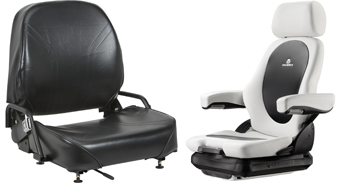 Evert Mallie |
Evert Mallie is managing director of EBLO which specialises in supplying operator seats to suit all kinds of work environments, helping to reduce harmful stress and increase driver safety and comfort.
Having been active in the seating world for almost 35 years, we have seen significant changes in forklift seating.
We've come a long way from the very simple static fixed bucket seat, with hardly any comfort or safety features, as seating has been adapted to the high-tech ergonomic working environment.
From the beginning, the problem with forklift seats has always been the restriction in height. Due to the fact that seats are usually fitted onto the engine cover, the available space to fit a decent seat is limited and this has caused serious headaches to the seating specialists and engineers.
The lower the seat, the smaller the suspension stroke and this again causes less comfort.
Forklifts are still heavy and rigid and most of them have solid tyres - both factors which seriously detract from comfort.
In the early 1980s, this began to change with the first semi-suspension seats coming onto the market. Slowly, some forklift manufacturers changed the design, allowing for higher, full-suspension seats to be installed. At the same time, seat manufacturers worked hard to design low-profile, full-suspension seats.
Over the years, knowledge of ergonomics grew and more comfort features were introduced, including adjustable lumbar supports and shaped cushions.
Meanwhile, attention was also devoted to safety, and more features were introduced, with seatbelts made mandatory in 2002. Then operator presence switches were required as part of the seats for electric forklifts, with other classes following.
In 2006, the new vibration regulations caused a massive change and more money is now spent to increase the driver's comfort and reduce harmful vibrations.
 Evolution: old design versus new technology |
Nowadays, high-tech seats - some with air suspension - are being installed with ergonomic joystick armrests, inflating, heated or cooled cushions and fully automatic weight adjustment.
Unfortunately, the main challenge stemming from height limitations prevails, but seat makers are able to compensate in creative and innovative ways.
- Find out more about EBLO at its website.